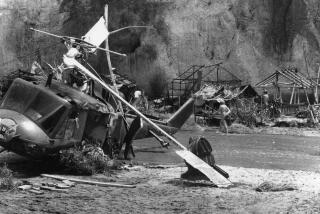‘Twilight’ Prosecutor Drops Bid to Repeat Defendants’ Remarks
- Share via
After three days of laborious hearings, the prosecutor in the “Twilight Zone” trial Wednesday abruptly withdrew her request to present as evidence statements made to authorities by the five defendants after the fatal 1982 film set helicopter accident.
Deputy Dist. Atty. Lea Purwin D’Agostino huffishly told Los Angeles Superior Court Judge Roger W. Boren that he was “unfair to the prosecution” for ruling that the jury would not be allowed to hear several potentially damaging lines from a statement made by director John Landis.
She said it would be “pointless” to present other, exculpatory portions of the 1982 Landis interview--as well as those of the other defendants--if she could not present key damaging parts.
At issue specifically was Landis’ reply to investigators when he was asked whether the helicopter was positioned in the same place during the fatal filming sequence as it was during a rehearsal. Said Landis: “Basically. It wasn’t exactly where it was going to be, but I figured that I didn’t care. . . .”
“I thought it was going to be further out over the river,” the director continued in his statement to the National Transportation Safety Board. “And when it came in and stopped and it was hovering, it was like, well, there, it’s hovering. OK, I’m going to get my shot.”
Landis and four associates are charged with involuntary manslaughter for alleged negligence that led to the helicopter crash in which actor Vic Morrow and two child actors were killed.
By taking her action, D’Agostino precluded herself from introducing potentially damaging statements made by other defendants that Boren had already ruled could be presented to the jury. Among them was an admission by helicopter pilot Dorcey Wingo that he never knew exactly where special-effects explosives--which struck the helicopter, resulting in the accident--had been placed.
As a result of D’Agostino withdrawing the statements, jurors will hear the defendants’ own explanations of the fatal accident only if the defendants decide to take the witness stand themselves.
Boren, in a pointed dialogue with D’Agostino, agreed that Landis’ statement “certainly reflects on Mr. Landis.”
But the statement, Boren added, “also reflects on other defendants--(and) there’s no way to sanitize it.”
His ruling was based on a 1965 state Supreme Court case that holds that in cases where two or more defendants are tried jointly, statements made by one defendant cannot be presented verbatim if they are damaging to another.
During the three days of hearings, Boren had been determining, line-by-line, what portions of the defendants’ statements could either be admitted as evidence, rejected or sanitized by taking out references to the other defendants.
Landis’ statement was impossible to sanitize, Boren declared, since the fact that Landis claimed that the helicopter was not in the proper position would automatically reflect on Wingo and perhaps on other defendants. If the defendants had been tried separately, Boren said, the statement could have been presented during Landis’ trial.
Outside of court, D’Agostino termed the judge’s ruling “erroneous.”
More to Read
Sign up for Essential California
The most important California stories and recommendations in your inbox every morning.
You may occasionally receive promotional content from the Los Angeles Times.








